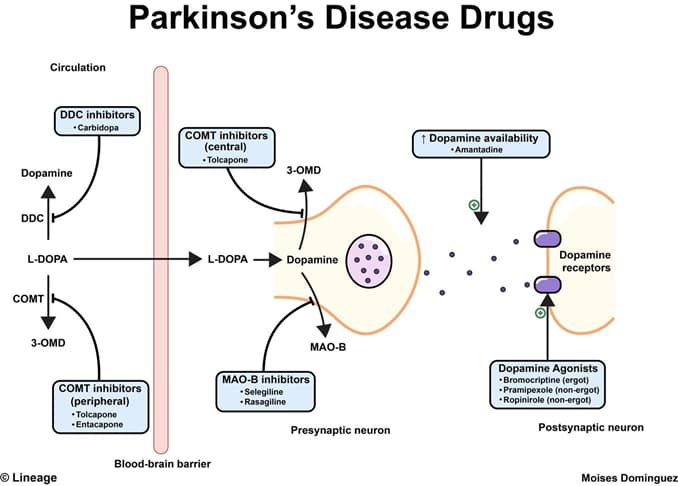Snapshot
- A 63-year-old male is brought to the physician by his wife for the evaluation of a tremor. The tremor is worse at rest, and decreases in severity with purposeful movement. The patient reports to having difficulty with initiating voluntary movement, and his wife states that the patient’s movements have been slow. On exam, there is seborrheic dermatosis on the nasolabial folds. There is a “pill-rolling” resting tremor accentuated when the patient is asked to perform mental calculations. Resistance to passive movement at the elbow joint is noted. On gait testing, there was difficulty with initiating gait, as well as the patient taking short steps when walking forward.
Introduction
- Neurodegenerative progressive movement disorder
- cardinal manifestations
- tremor
- resting, “pill-rolling”
- bradykinesia
- muscle rigidity
- postural instability
- tremor
- associated with lewy bodies
- cardinal manifestations
- Pathophysiology
- Secondary parkinsonism
- loss or interference with the action of dopamine in the basal ganglia
- carbon monoxide poisoning
Presentation
- Symptoms
- motor involvement
- resting pill-rolling tremor
- bradykinesia
- muscle rigidity
- cogwheel rigidity
- postural instability
- shuffling gait
- mask-like facies
- depression
- dementia
- motor involvement
- usually a late finding
Evaluation

- Clinical diagnosis
- Histology
- loss of pigmented neurons in the substantia nigra
- round eosinophilic inclusions of α-synuclein
Differential
- Lewy body dementia
- Alzheimer’s disease
- Essential tremor
- Parkinson-plus syndromes
- multiple system atrophy (Shy-Drager syndrome)
- olivopontocerebellar atrophy
- supranuclear palsy
- Drug-induced parkinsonism
Treatment

- Pharmacologic treatment
- levodopa-carbidopa
- dopamine agonist
- pramipexole
- bromocriptine
- ropinirole
- monoamine-oxidase type B (MAO-B) inhibitors
- selegiline
- amantadine
- anticholinergics
- benztropine
- trihexyphenidyl
- Surgical treatment
- deep brain stimulation
- thalamotomy
- pallidotomy
Prognosis, Prevention, and Complications
- Prognosis
- a chronic progressive disorder
- treatment improves quality of life and function
- a chronic progressive disorder
- Prevention
- currently not a preventable disease
- Complications
- dementia
- depression
- psychosis/hallucinations
- pneumonia
- most common cause of death



